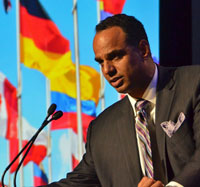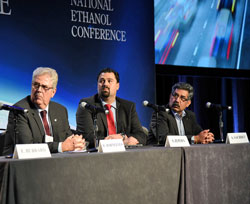 Alliance BioEnergy Plus, Inc. has announced its CTS pilot plant located at the Company’s subsidiary Ek Laboratories, is now running the complete conversion process from raw feedstock through fermentation of cellulosic sugars. This full conversion process also includes the separation of the valuable pure lignin and the recycling of catalyst and unreacted cellulose back to the front of the process.
Alliance BioEnergy Plus, Inc. has announced its CTS pilot plant located at the Company’s subsidiary Ek Laboratories, is now running the complete conversion process from raw feedstock through fermentation of cellulosic sugars. This full conversion process also includes the separation of the valuable pure lignin and the recycling of catalyst and unreacted cellulose back to the front of the process.- Amyris, Inc. has announced that it closed a $20 million private placement of unsecured promissory notes to existing investors. In connection with this financing, the company also issued warrants for 2.9 million shares of common stock. The private placement was led by a long-term investor affiliated with one of Amyris’s board members, John Doerr, of the venture capital firm Kleiner Perkins Caufield & Byers, and included participation by Biolding Investment S.A. and Naxyris S.A., which are also associated with members of the company’s board of directors.
- The Pennsylvania Department of Environmental Protection (DEP) is encouraging Pennsylvanian business and community leaders to be better caretakers of the environment by offering incentives for the purchase and use of alternative fuels and alternative fuel vehicles. DEP’s Alternative Fuels Incentive Grant (AFIG) Program offers funding for innovative, advanced fuel and vehicle technology projects for cleaner alternative transportation within the commonwealth.
#Ethanol Export Trends from #RFANEC
 Expansion of ethanol exports is critical to allow U.S. industry to grow in face of domestic infrastructure challenges, which is why exports were such a big focus at the 21st National Ethanol Conference last week.
Expansion of ethanol exports is critical to allow U.S. industry to grow in face of domestic infrastructure challenges, which is why exports were such a big focus at the 21st National Ethanol Conference last week.
“We are firmly committed to help grow and expand export markets for our members and for the industry,” said Renewable Fuels Association General Counsel Ed Hubbard, who moderated two panels at the NEC discussing export trends and opportunities. RFA was selected to partner with the Department of Commerce’s International Buyer Program at the conference which focused on five main target markets – Brazil, China, Philippines, India, Mexico. “The markets were part of the top markets report prepared by the Department of Commerce, which was the result of careful analysis on export markets to look at where the opportunities for our industry lie,” Hubbard added.
 The first panel on exports featured Ricardo Dornelles with the Ministry of Mines and Energy of Brazil; Stephan Zepeda of Grupo Báltico in Mexico; and Amit Sachdev, Consultant in South Asia, U.S. Grains Council.
The first panel on exports featured Ricardo Dornelles with the Ministry of Mines and Energy of Brazil; Stephan Zepeda of Grupo Báltico in Mexico; and Amit Sachdev, Consultant in South Asia, U.S. Grains Council.
Links to presentations from each are found below:
Ricardo Dornelles presentation
Stephen Zepeda presentation
Amit Sachdev presentation
Listen to the panel here: Ethanol Exports Panel 1
The second panel on exports featured Max Thomasson, CHS Inc. Director for Global Trading; U.S. Grains Council Chief Economist Mike Dwyer; Eco-Energy International Director Alexandre Zebulun Ades; and Scott Richman, Senior Vice President at Informa Economics.
Listen to that panel here and presentations via links below: Listen to the panel here: Ethanol Exports Panel 2
Growth Energy Holds Executive Leadership Conference
 Growth Energy is holding its annual Executive Leadership Conference this week in Orlando, FL. Most of the members got the opportunity to attend the Daytona 500 race this past weekend. Now it’s time for business.
Growth Energy is holding its annual Executive Leadership Conference this week in Orlando, FL. Most of the members got the opportunity to attend the Daytona 500 race this past weekend. Now it’s time for business.
The emcee for the event is Kim Coon, former Miss Sprint Cup and announcer for Motor Racing Network. On the stage this morning will be Jeff Broin, Chairman for Growth Energy and Tom Buis, CEO. Keynote speakers include Chuck Todd, MSNBC and Brent Dewar, NASCAR. There are several panel discussions and a membership forum before the conference concludes on Tuesday.
I will be speaking with Jeff Broin and Tom Buis to get their outlook on the industry and for the future of Growth Energy. More to come.
Ethanol Co-product Exports Set Record in 2015
 Exports of the ethanol co-product and livestock feed distillers grains set a new record of 12.56 million metric tons last year, according to a new summary of ethanol co-product trade statistics released by the Renewable Fuels Association (RFA). U.S. exports of distillers grains were 11 percent higher than 2014, and more than double the amount exported in 2009.
Exports of the ethanol co-product and livestock feed distillers grains set a new record of 12.56 million metric tons last year, according to a new summary of ethanol co-product trade statistics released by the Renewable Fuels Association (RFA). U.S. exports of distillers grains were 11 percent higher than 2014, and more than double the amount exported in 2009.
“This report shows the global reach of American-made distillers grains,” said RFA president and CEO Bob Dinneen. “In 2015, an estimated 34 percent of U.S. distillers grains production was exported, meaning one out of every three tons produced was shipped to foreign markets. These data make it crystal clear that the U.S. ethanol industry is both fueling and feeding the world. It is also worth noting that DG exports were worth almost $3 billion in 2015, providing a critical source of revenue to ethanol producers.”
The report finds that U.S. DG exports were shipped to 45 countries on five continents in 2015. RFA’s summary shows exports of distillers grains were shipped to 45 countries on five continents in 2015 with China, Mexico, Vietnam, South Korea, and Canada representing the top five markets. Half of the exports went to China, Mexico received 13 percent, and both Vietnam and South Korea received five percent.
Ethanol Evolution Sees Industry Consolidation
This week in New Orleans, “Ethanol Evolution: The Data and Deals Driving the Future,” was a topic during the 21st Annual National Ethanol Conference (#RFANEC). The panel was moderated by Mike Jerke, CEO, Guardian Energy; and included Mark Fisler, Managing Director, Ocean Park Advisors; and John Christianson, Primary Partner, Christianson & Associates, PLLP.
 During the discussion, Fisler said that the North American biofuels industry saw a major consolidation of players last year and this year is pointing to the same trend.
During the discussion, Fisler said that the North American biofuels industry saw a major consolidation of players last year and this year is pointing to the same trend.
“Our experience leads us to believe there will be an increased number of owners and boards of renewable fuel companies evaluating their options in 2016, if not testing the market for reasonable assessments of the value of their plants,” noted Fisler. He added that the ethanol industry in particular is ripe for consolidation although there are still 94 standalone ethanol plants that have annual production capacity of 5.3 billion gallons, or about 36 percent all North American ethanol production volumes.
To learn about about this trend as well as how the ethanol industry is faring financially, listen to the Ethanol Evolution panel discussion: Ethanol Evolution Panel
OPIS’ Tom Kloza Discusses Energy Markets
 During the 21st Annual National Ethanol Conference (#RFANEC) this week, one of the hot topics was the energy and ethanol market outlooks especially with the low oil prices the globe is currently experiencing. Tom Kloza with the Oil Price Information Service (OPIS) offered attendees the outlook for ethanol, oil and natural gas markets in his presentation, “Wronger for Longer – sideways look at North American Energy Supply.”
During the 21st Annual National Ethanol Conference (#RFANEC) this week, one of the hot topics was the energy and ethanol market outlooks especially with the low oil prices the globe is currently experiencing. Tom Kloza with the Oil Price Information Service (OPIS) offered attendees the outlook for ethanol, oil and natural gas markets in his presentation, “Wronger for Longer – sideways look at North American Energy Supply.”
“What would you have imagined would be more unlikely 3 or 4 years ago?” Kloza asked in his introduction. “That a hip-hop version of Alexander Hamilton would win the Tonys on Broadway? That America’s Dad Bill Cosby would be America’s serial rapist? Or that the person who was the greatest athlete in the world in 1976 Bruce Jenner was now a woman? Or that oil prices were a $110 a few years ago and now are struggling to get out of the 20s?”
Your answer may change after you listen to Kloza’s remarks here: Tom Kloza, OPIS, Energy Markets Outlook Remarks View Power Point presentation.
Abigail Fisler Shares Her #RFANEC Experience
 Abigail Fisler was the recipient of this year’s National Ethanol Conference (NEC) scholarship awarded by the Renewable Fuels Foundation. She is a junior at Dickinson College in Carlislie, PA studying environmental studies with a focus on renewable energy and climate change. Last year she attended her first NEC show and wanted to attend again because of all the great educational and networking opportunities.
Abigail Fisler was the recipient of this year’s National Ethanol Conference (NEC) scholarship awarded by the Renewable Fuels Foundation. She is a junior at Dickinson College in Carlislie, PA studying environmental studies with a focus on renewable energy and climate change. Last year she attended her first NEC show and wanted to attend again because of all the great educational and networking opportunities.
Before she headed back to the books, she spoke with Cindy Zimmerman about some of the highlights of her time at the ethanol conference. She prefaced her answer with “that’s a tough one” but noted she really enjoyed the panel that included Alicia Lindauer with the U.S. Department of Energy (DOE). “I grabbed her at the networking reception and talked with her about what her career path has been and about her education path that led her there, and I thought it was really interesting to talk with her.”
Other areas that particularly interested her were discussions around why some areas are implementing E15 and other areas are not, and why some places have lots of flex fuel vehicles while others don’t.
To learn more about Abigail’s growing interest in renewable fuels (she’s been a fan since 4th grade) and to hear more about her NEC experience, listen to Cindy Zimmerman’s interview with NEC Scholarship winner Abigail Fisler: Interview with Abigail Fisler
Comet Biorefining to Build Biomass to Sugar Plant
TransAlta Energy Park located in Sarnia, Ontario will be the new home of a commercial scale biomass to sugar facility operated by Comet Biorefining. The facility is expected to be operational by 2018 and will produce 60 million pounds per year of dextrose sugar from locally sourced corn stover and wheat straw.
 Comet, using its proprietary patented process, coverts the biomass into sugar and then the sugar will be converted into biobased products including organic acids, amino acids and bioplastics. The company notes that the biobased products will replace petroleum-based materials, reduce greenhouse gas emissions and help Canada reach its climate reduction goals. Comet also says its dextrose is cost and performance competitive with commercial dextrose sugars.
Comet, using its proprietary patented process, coverts the biomass into sugar and then the sugar will be converted into biobased products including organic acids, amino acids and bioplastics. The company notes that the biobased products will replace petroleum-based materials, reduce greenhouse gas emissions and help Canada reach its climate reduction goals. Comet also says its dextrose is cost and performance competitive with commercial dextrose sugars.
Andrew Richard, CEO of Comet said, “Construction of this first-of-a-kind plant represents a key step towards the large-scale commercialization of our cellulosic sugar business. It highlights the important role our technology plays in the value chain, helping to drive the bioeconomy and reduce greenhouse gas emissions.”
The company says it chose to locate in Sarnia by working together with Bioindustrial Innovation Canada (BIC), the Ontario Federation of Agriculture (OFA) and an Ontario farmers’ cooperative on a project to attract sustainable technology providers to the region and to meet increasing demand from chemical suppliers and consumers for low-carbon products.
“Establishing new uses for agricultural residues in the bio-based chemical supply chain leads to sustainable farms and new markets. Both outcomes are primary goals of the OFA, and this project does just that,” added Don McCabe, OFA’s president.
#RFANEC Biofuels Policy Panel
 The future of U.S. biofuels policy was the topic of a panel at the 2016 National Ethanol Conference this week in New Orleans.
The future of U.S. biofuels policy was the topic of a panel at the 2016 National Ethanol Conference this week in New Orleans.
Renewable Fuels Association (RFA) president and CEO Bob Dinneen moderated the panel, which included industry and government stakeholders, but no representative from the Environmental Protection Agency, even though they were invited to participate. “They had expressed some real enthusiasm for talking about this with us,” said Dinneen. “On December 8th, when we filed a lawsuit (against EPA over the RFS volume obligations), the enthusiasm waned a bit.”
Alicia Lindauer with the U.S. Department of Energy did join the panel, representing the government. “Quite frankly, the Department of Energy is doing far more in terms of the analysis and work on future fuel and technology,” Dinneen said.
Also on the panel was Fuels Institute Executive Director John Eichberger and Jan Koninckx, Global Business Director for Advanced Biofuels with DuPont Industrial Biosciences. Listen to their conversation here: NEC Biofuels Policy Panel
Price of Oil Crushes Liquid Transportation Fuels
This is a special editorial authored by Joanna Ivancic, executive director for Advanced Biofuels USA. It is based on a two-part series looking at how low crude prices are affecting biofuels.
Price of Oil Crushes Liquid Transportation Fuels–Renewable and Not — Now What?
“Europe should promote the development of home-grown alternatives to imported oil and gas,” according to former NATO Secretary General Anders Fogh Rasmussen, who was  Danish Prime Minister from November 2001 to April 2009 in an interview with Bloomberg’s Ewa Krukowska about Russian domination of European energy resources. “Wind and solar are well-known success stories but I’d also point to biofuels as an example of an alternative energy source with a lot of potential.”
Danish Prime Minister from November 2001 to April 2009 in an interview with Bloomberg’s Ewa Krukowska about Russian domination of European energy resources. “Wind and solar are well-known success stories but I’d also point to biofuels as an example of an alternative energy source with a lot of potential.”
In the US, in a two-part series, Advanced Biofuels USA correspondent Robert Kozak identifies the same concerns for energy security and the same solution–development of home-grown alternatives.
In addition, his analyses of the effect of low oil prices on the liquid transportation fuels industry and the potential for a reinvigorated US shale oil/gas industry with and without government subsidies reflects this growing international appreciation that we are at a crossroads, at a moment when the energy choices we make will have far-reaching consequences.
Either we will continue in an energy resource system where the energy czars have their boots on the necks of importing countries; or we grab the reins of freedom to become self-sustaining. Either we continue to pollute our air and water to the point that unrest threatens or we use the technologies that science gives us to reverse our harmful stewardship of the planet.
In Part 1 of the series, Why Oil Is Cheap in October 2015, Kozak points out that the bottom fell out of business-as-usual in the oil industry not only due to oversupply, but due to that oversupply being offered at below market prices to finance continued conflict in the Middle East.
In Part 2, “After the Fall: Rebuilding US Liquid Fuel Production – Invest in Our Land or the Shale Oil Fields?” Kozak reviews recent experts’ predictions about the trajectory of oil prices, analyses how they went wrong and the current situation of debt and decline in the US shale oil/gas industry.Read More

